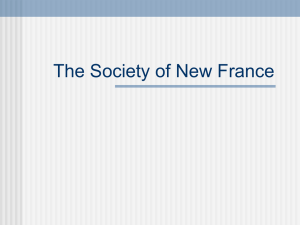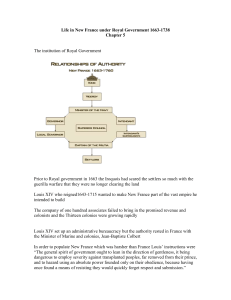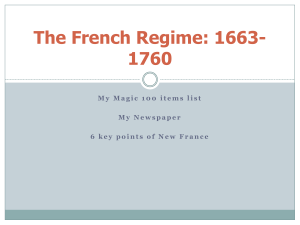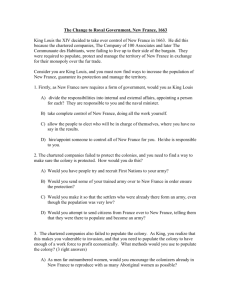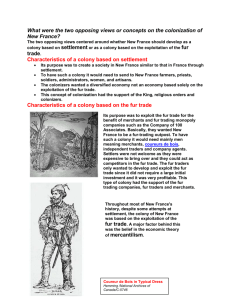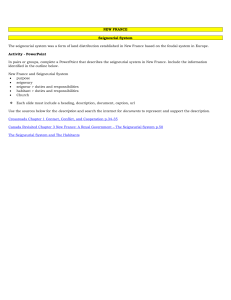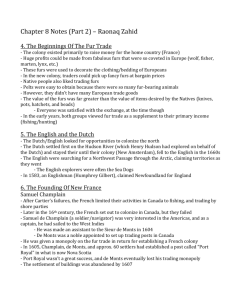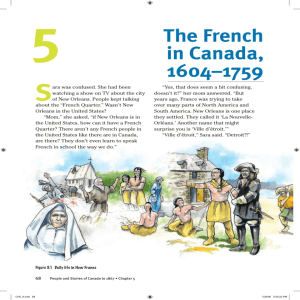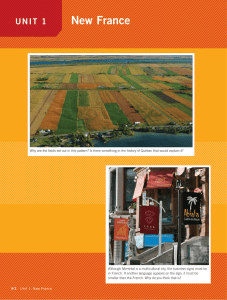HIS30S – Life in New France Introduction Nouvelle France is the
advertisement
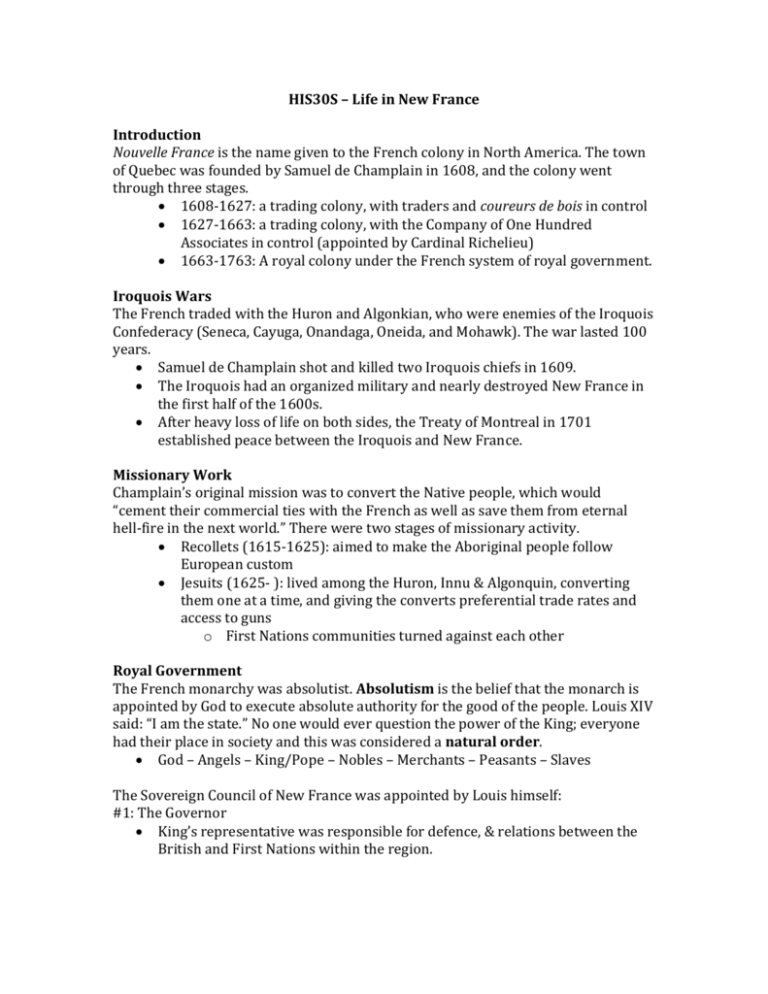
HIS30S – Life in New France Introduction Nouvelle France is the name given to the French colony in North America. The town of Quebec was founded by Samuel de Champlain in 1608, and the colony went through three stages. 1608-1627: a trading colony, with traders and coureurs de bois in control 1627-1663: a trading colony, with the Company of One Hundred Associates in control (appointed by Cardinal Richelieu) 1663-1763: A royal colony under the French system of royal government. Iroquois Wars The French traded with the Huron and Algonkian, who were enemies of the Iroquois Confederacy (Seneca, Cayuga, Onandaga, Oneida, and Mohawk). The war lasted 100 years. Samuel de Champlain shot and killed two Iroquois chiefs in 1609. The Iroquois had an organized military and nearly destroyed New France in the first half of the 1600s. After heavy loss of life on both sides, the Treaty of Montreal in 1701 established peace between the Iroquois and New France. Missionary Work Champlain’s original mission was to convert the Native people, which would “cement their commercial ties with the French as well as save them from eternal hell-fire in the next world.” There were two stages of missionary activity. Recollets (1615-1625): aimed to make the Aboriginal people follow European custom Jesuits (1625- ): lived among the Huron, Innu & Algonquin, converting them one at a time, and giving the converts preferential trade rates and access to guns o First Nations communities turned against each other Royal Government The French monarchy was absolutist. Absolutism is the belief that the monarch is appointed by God to execute absolute authority for the good of the people. Louis XIV said: “I am the state.” No one would ever question the power of the King; everyone had their place in society and this was considered a natural order. God – Angels – King/Pope – Nobles – Merchants – Peasants – Slaves The Sovereign Council of New France was appointed by Louis himself: #1: The Governor King’s representative was responsible for defence, & relations between the British and First Nations within the region. #2: The Intendant The Intendant were responsible for daily economic affairs, trade, justice, finance, settlement and the seigneurial system. #3: The Bishop The Bishop was responsible for the spiritual needs of the colony and social welfare, including the spread of Christianity to the aboriginals, education/schools, charities, and hospitals. Catholic Church Jesuits did not have as much power when NF became a royal province, but the Church was still involved in governance: Church owned a lot of land People were expected to give 1/26 of crops to church Church orders, like the Grey Nuns, ran all hospitals and schools As a result, people in New France were actually better cared for than the people back home. The church was highly respected. Jean Talon and Recruitment Jean Talon was the King’s Intendant in France from 1665-1672. He was much more successful at recruiting colonists than previous leadership. Immigrants were mostly young, adventurous, and urban, leaving behind growing French cities, which could be crowded and unhealthy. Les Filles du Roi, or “The King’s Daughters”, were the approximately 800 orphan girls from France that were sent to NF between 1663 and 1673, for the sole purpose of marrying and having children. Within weeks of their arrival to NF they became involved in arranged marriages. Even after female migration, only 1 in 5 colonists was a woman. Soldiers who settled in NF originally came to the region on military duties & were encouraged to stay with the promise of free land once their military service had ended. Hired workers (general labourers, construction workers, etc.), initially came to NF to work on three year contracts. Many decided to stay in order to marry and have a large family. Talon implemented several strategies to help increase the population of the colony. Fines were given to fathers if their children did not marry before a certain age. For familes with over 10 children, financial allowances were provided to parents. Couples who married young received financial aid. Many bachelors were fined and not allowed to participate in the fur trade. Economy The fur trade made New France economically viable. (If there was no fur trade, New France would not have made enough money to survive.) The colony’s role was to supply France with raw materials – this relationship is called mercantilism. Jean Talon promoted industry, so that the colony produced its own clothes, tools, etc. Seigneurial System Seigneurs owned the land; habitants worked the land. The Seigneur’s responsibilities included: Granting land to settlers Building the mill in the community. Helping settle disputes in court. Protection of the colonists. The habitants were the settlers in NF. They: Lived on and cultivated the land. Paid rent to the seigneur. Provided the seigneur with 1/10 of all fish caught each year. Provided the seigneur with a portion of the grain ground in the flour mill. Paid the seigneur for using the common land for cutting firewood or for grazing animals. Seigneurial plots were long & narrow farm lots perpendicular to the St. Lawrence River which provided settlers with access to the river. A second row of farms were created when all the river front land was taken. A road was also created parallel to the river. Coureur de Bois The term “Coureur de Bois” means Runners of the Woods. These men were unlicensed fur traders who lived an independent and adventurous lifestyle. As beaver became scarce along the St. Lawrence lowlands, French traders began to travel farther north to trade with First Nations. Even after the HBC was created, the Coureur de Bois often broke the monopoly and hunted on HBC land. They had strong connections with the First Nations and their way of life, and many married First Nations women. Picture #1 Picture #2 Picture #3 Picture #4 Picture #5 Picture #6

